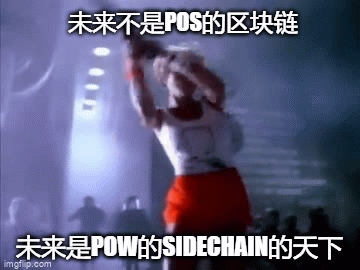Data: The security threats facing Bitcoin are becoming increasingly severe
Author: LayerTwo Labs

For a long time, Bitcoin has been regarded as the safest cryptocurrency, boasting the highest mining power and the most nodes, earning the title of digital gold. Its safe-haven properties are frequently discussed in the financial markets.
Compared to innovation and risk, the Bitcoin community and the Bitcoin Core team place greater emphasis on the overall security of the network, reducing or even rejecting changes, in an attempt to maintain this security attribute and the status it brings.
However, the reality is that the security issues facing the Bitcoin network are becoming increasingly real and imminent.
Continuously Decreasing Bitcoin Security Costs
Under the POW consensus mechanism, the security of the Bitcoin network is provided by miners engaged in mining, but it is not guaranteed by computing power; rather, it is determined by the miners' costs/benefits. This is because the motivation to attack, excluding malicious destruction by hostile forces, is profit-driven.
Therefore, the security cost of the Bitcoin network equals the cost and benefits of attackers, where the benefits are the sum of block rewards and transaction fee income.
We can observe from the data statistics that the security of Bitcoin is declining.
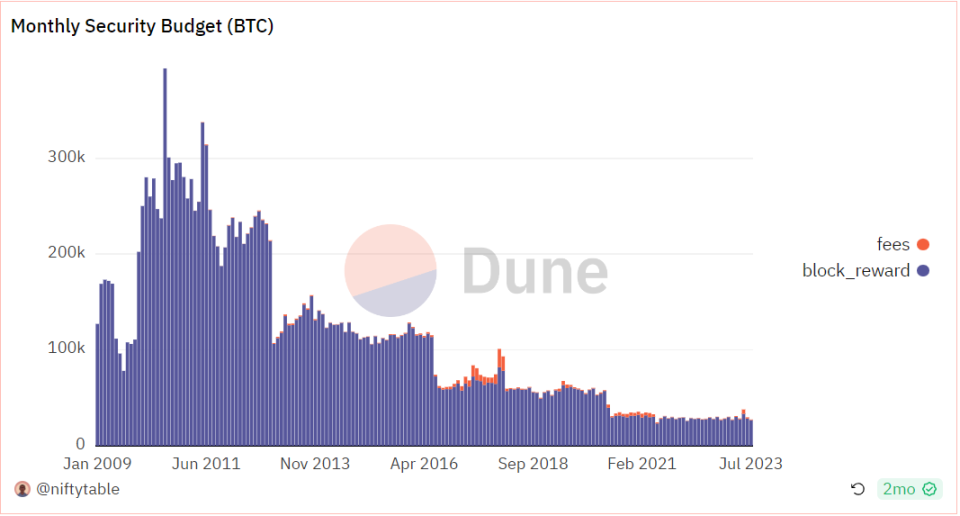
Monthly Bitcoin Security Costs - Chart 1 in BTC

Monthly Bitcoin Security Costs - Chart 2 in USD
The above charts show the changes in Bitcoin's monthly security costs since 2009. Chart 1 is priced in BTC, and Chart 2 is priced in USD. From Chart 2, we can see that the current security cost of the Bitcoin network is actually lower than in 2021, despite the fact that the network's computing power has increased exponentially during this period.
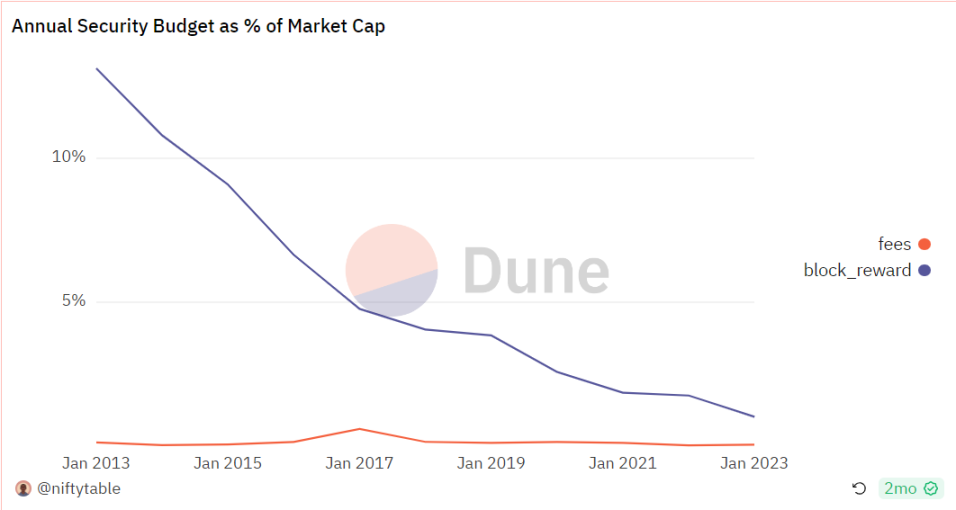
The above chart shows the proportion of block rewards and transaction fees in Bitcoin's market value.
The above chart illustrates the proportion of block rewards and transaction fees in Bitcoin's market value. Since these three data points are all priced in Bitcoin, this proportion shows a downward trend. The proportion of block rewards is continuously decreasing due to halving, while the proportion of transaction fees shows no sign of improvement. Under this trend, the continuous reduction of Bitcoin's security costs will be inevitable.
Increasing Possibility of Attacks
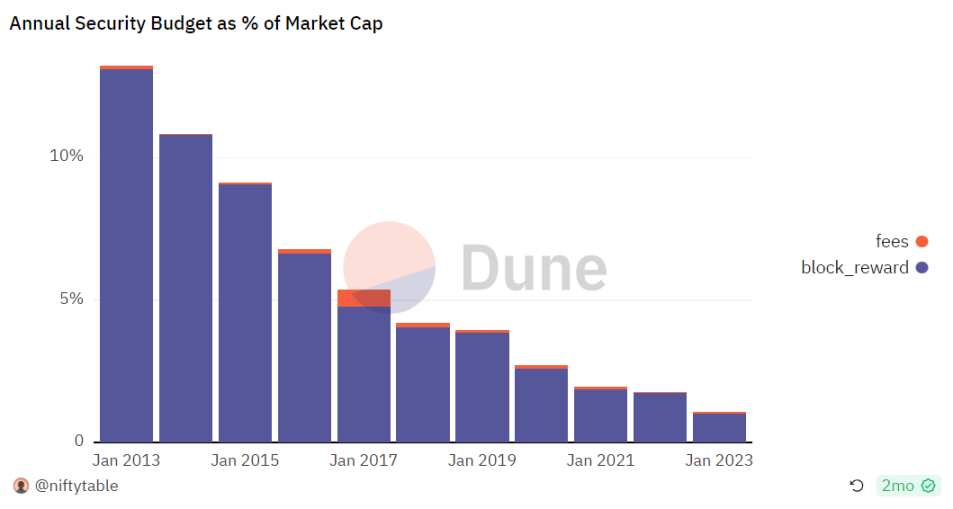
This chart also tells us that the growth rate of Bitcoin's market value far exceeds the growth rate of security costs, as prices are rising, while the major component of current security costs, block rewards, is halved every four years. Data statistics show that Bitcoin's price maintains an annual growth of over 19%, which can offset the decline in security costs due to block reward halving, but we all know that this is unrealistic in the long run. Looking at it from another perspective, even if such growth is maintained, the decline in computing power and mining costs will render this price increase meaningless.
As Bitcoin's market value rises, the potential profits from attacks increase, and the likelihood of it being attacked also grows.
On the other hand, the cost of conducting attacks is decreasing. Bitcoin's energy consumption issue has long been criticized, but more and more miners are using clean energy and new energy sources for mining, including some government actions. These miners have become less sensitive to energy costs, meaning that the costs for potential attackers are decreasing.
Increasing Miner Fee Income = Enhancing Bitcoin Security
Since block rewards are mostly fixed and gradually approach zero, fee income becomes crucial.
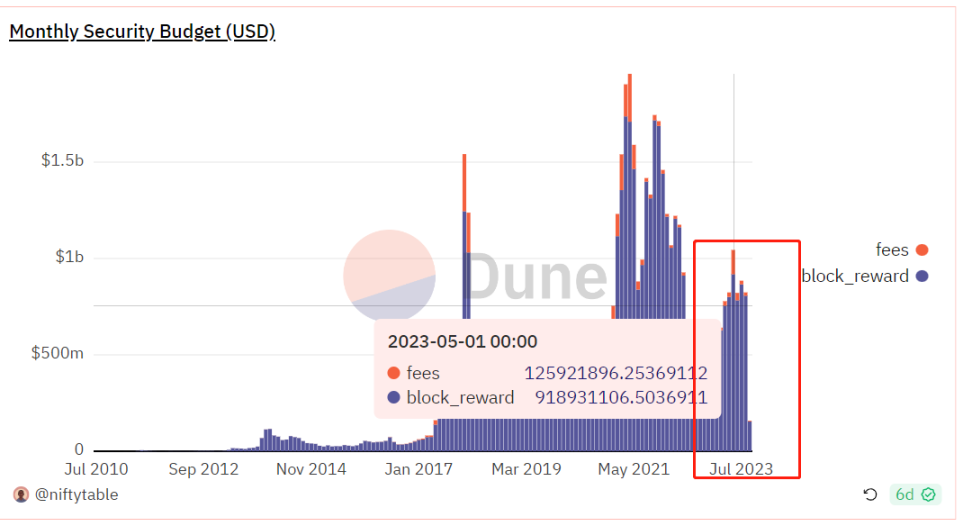
From this chart, we can clearly see that when block rewards are nearly equivalent, in May 2023, Bitcoin's security costs reached their highest point in nearly a year, while the fee income in May was the highest during the same period.
This gives us the answer: in the context of Bitcoin's block rewards halving every four years, increasing miner fee income is essential for enhancing the security of the Bitcoin network. When all Bitcoin has been mined, miner fee income will constitute all of Bitcoin's security costs.
Security is not solely determined by its own system but is influenced by the entire environment. As the Chinese proverb goes, "The most dangerous place is the safest place."
Security is attractive to those outside the cryptocurrency industry, while for most people within the crypto industry, its appeal has become less than the potential for high returns. Even if they still trust Bitcoin's security, more often than not, it has become a defensive choice in a bear market rather than a means to generate profits.
Due to the critical role of fees in security, Bitcoin's scalability and use-value issues, along with network security, form a flywheel that complements each other. Bitcoin needs to establish its security in various environments and must engage in innovative actions to increase fee income, creating benefits for holders and enhancing adoption.
Increasing Transaction Volume, Not Increasing Individual Fees
The growth of fees in May 2023 stemmed from the emergence of Ordinals, and we can clearly see that it was not sustainable. This is due to issues with Ordinals themselves, as well as problems with Bitcoin.
During the peak of Ordinals, the transaction fee for a single Bitcoin transaction reached hundreds of dollars, which is unacceptable for the vast majority of people. Such actions that only increase the unit price of fees will force people to abandon the use of Bitcoin, ultimately leading to more destructive results. Due to the existence of altcoins, even though they may not be as secure, if they offer more use value, profit opportunities, and lower fees, then over time, these altcoins will become competitors to Bitcoin. Paul Sztorc, the founder of Layer 2 Labs, has discussed this early on (https://www.truthcoin.info/blog/security-budget/).
If we do not wish to see Bitcoin's downfall or inflation, then expanding capacity and increasing Bitcoin transaction volume is the only choice.

Most Layer 2 transactions do not pay fees to Layer 1 miners. The Lightning Network will flow to other LN nodes to compensate them for their risks, operating capital, channel management, reliability, uptime, etc. For state chains, there may be no fees at all (or possibly paid through LN).
Transaction fees on Liquid go directly to Blockstream. For hosted L2s, there may be no fees at all.
For OpenDime/ColdCard, IntelSGX/Teechan will not pay any fees to Layer 1 miners.
DriveChain is bringing more use cases and transactions to Bitcoin through sidechains. Based on BIP-300 and BIP-301, DriveChain can introduce various sidechains to Bitcoin and allocate the transaction fees from sidechains to Bitcoin mainnet miners without requiring miners to incur any additional costs.
Based on DriveChain, developers can also enjoy a very friendly development environment and directly access the vast user base of the Bitcoin community. The RSK community is already seriously discussing joining DriveChain as a sidechain.
